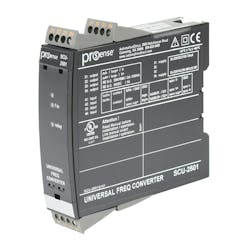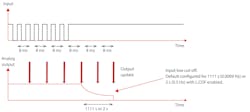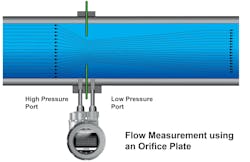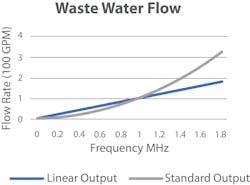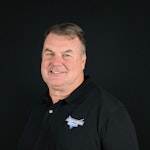Frequency signal conditioner applications
Many automation applications rely on the ability to sense high-frequency pulses. When properly designed, high-speed pulse detection is a reliable way to identify the speed and amount of travel of mechanical equipment, and this principle is widely used throughout industry. One example would be the rapid pulses generated by a solid-state proximity switch sensor arranged to detect teeth on a spinning sprocket. Another is when a digital controller monitoring rapidly moving equipment provides a high-speed pulse output which can be connected to a second digital system which must be closely coordinated with the first.
For applications like these, a universal frequency signal conditioner is often used to connect a high-speed sensor to a supervisory digital controller, or to other hardwired equipment or displays. Certainly, a modern programmable logic controller (PLC) operates with very fast scan times, and discrete input (DI) modules can detect signals at a relatively high frequency, so it can be possible for a PLC to directly monitor and act on a high-frequency signal. But there are plenty of cases where it makes sense to specify a universal signal conditioner to connect a high-speed sensor to the supervisory controls.
The AutomationDirect ProSense SCU Series universal signal conditioners (SCU-2501, SCU-2502, and SCU-2503), for example, are extremely versatile, providing the flexibility to convert, transmit, scale and isolate frequency input signals from a wide variety of process sensors and controller I/O (Figure 1). They operate on standard AC and DC voltages found in typical industrial control panels and equipment, are compact and DIN rail mountable. They are available with a detachable LCD programming/display module, which is used to program them, copy configurations and provide a local display if needed.
The single input point accepts frequency signals up to 100 kHz from NPN, PNP, TTL, tachometer and NAMUR sensors. Depending on the model, the output can be a unipolar or bipolar current, a voltage or frequency signal, or programmable relays. They also provide three-way isolation between the input, output and power.
Universal signal conditioners provide an economical solution to conditioning frequency signals for use by PLCs, controllers or basic input displays. Here are two real-world examples.
Industrial washing machine clutch control
A factory ages and finishes denim blue jeans using industrial-size washing machines. When the controls need to transition from low to high speed, a pneumatic clutch disengages the low-speed motor so the washer can enter the high-speed water extraction cycle. Although a pneumatic sensor indicates that the clutch has been depressurized and the low-speed motor has been decoupled, as this system ages the clutch assembly can sometimes stay engaged to the motor when the assembly depressurizes, which can cause an extremely dangerous condition.
An additional safety measure is to design the controls to sense the RPM of the clutch itself and stop the machine if the RPM exceeds a safe limit. The clutch has a 6-spoke sheave that can be counted with a proximity sensor, but the existing controls could only accept an RPM input of up to 20 RPM.
An SCU Series signal conditioner solves this problem as it can be configured to monitor the pulses, and then divide the count by 6 to indicate the RPM to the existing control. The SCU-2501 units can also use a relay output to stop the machine if the RPM exceeds the safe limit.
Flowmeter monitoring
Impeller-type flowmeters spin a shaft as liquid flows through a pipe, and the shaft is equipped with a sensor that detects each revolution and provides a pulsed frequency output. This type of meter typically gives an NPN frequency output that can be converted to a flow in engineering units by dividing the frequency by a K-factor.
The SCU-2503 signal conditioner can be used to convert this frequency signal to instantaneous flow as an analog output signal usable by a host monitoring or control system, and it can also trigger a discrete output to indicate high or low flow for monitoring purposes.
Additionally, the signal conditioner can be programmed to ignore the low frequency pulses that can occur when the water supply is abruptly stopped by closure of the valves, which is useful for making the flow total more accurate by eliminating any low frequency oscillation of the impeller (Figure 2).
Differential pressure flowmeter
Orifice and wedge style flow meters are ideal for multiple applications because they can measure high flow rates and are unaffected by material in the stream (Figure 3).
For these applications, a differential pressure transmitter is connected to measure the pressures at both the flowmeter input and output, and it provides a frequency output that is proportional to the difference between high-pressure and low-pressure sides of the wedge meter. However, this signal output relationship to flow is actually a squared function, and not linear.
The SCU-2501-3 can be used to condition this input by using a square root function, and then transmitting an output as either a linear frequency or an analog signal for use by a host system (Figure 4). The linearized output can then be easily and accurately used to display the wastewater flow.
Universal signal conditioners provide options
The AutomationDirect ProSense SCU Series of universal signal conditioners can be used for many applications, both new and retrofit, by converting signals as required. These signal conditioners can solve complex problems presented by a variety of frequency signal applications, and the versatility of this family of signal conditioners is one of its main benefits for greatly enhancing existing sensors and applications.
